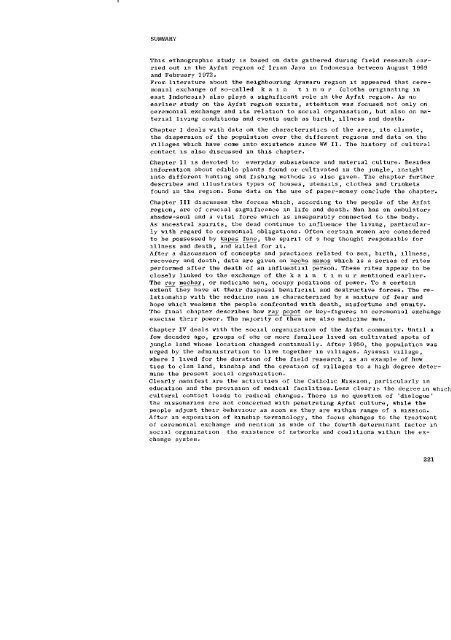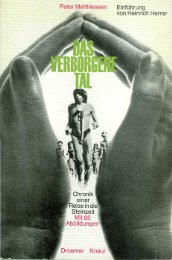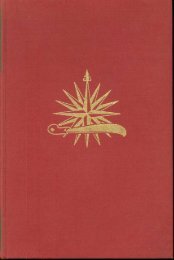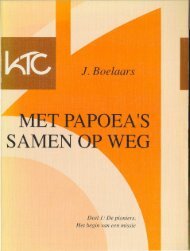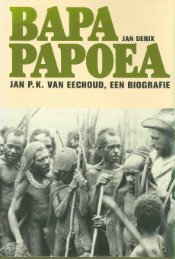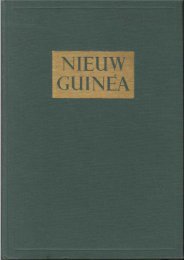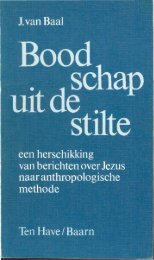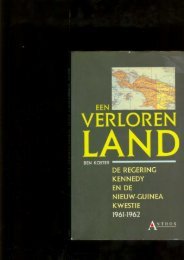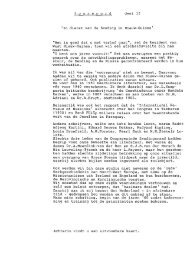mensen van de ayfat - Stichting Papua Erfgoed
mensen van de ayfat - Stichting Papua Erfgoed
mensen van de ayfat - Stichting Papua Erfgoed
You also want an ePaper? Increase the reach of your titles
YUMPU automatically turns print PDFs into web optimized ePapers that Google loves.
SUMMARY<br />
This ethnographic study is based on data gathered during field research carried<br />
out in the Ayfat region of Irian Jaya in Indonesia between August 1969<br />
and February 1972.<br />
From literature about the neighbouring Ayamaru region it appeared that ceremonial<br />
exchange of so-called kain timur (cloths originating in<br />
east Indonesia) also plays a significant role in the Ayfat region. As no<br />
earlier study on the Ayfat region exists, attention was focused not only on<br />
ceremonial exchange and its relation to social organisation, but also on material<br />
living conditions and events such as birth, illness and <strong>de</strong>ath.<br />
Chapter I <strong>de</strong>als with data on the characteristics of the area, its climate,<br />
the dispersion of the population over the different regions and data on the<br />
villages which have come into existence since WW II. The history of cultural<br />
contact is also discussed in this chapter.<br />
Chapter II is <strong>de</strong>voted to everyday subsistence and material culture. Besi<strong>de</strong>s<br />
information about edible plants found or cultivated in the jungle, insight<br />
into different hunting and fishing methods is also given. The chapter further<br />
<strong>de</strong>scribes and illustrates types of houses, utensils, clothes and trinkets<br />
found in the region. Some data on the use of paper-money conclu<strong>de</strong> the chapter.<br />
Chapter III discusses the forces which, according to the people of the Ayfat<br />
region, are of crucial significance in life and <strong>de</strong>ath. Man has an ambulatory<br />
shadow-soul and a vital force which is inseparably connected to the body.<br />
As ancestral spirits, the <strong>de</strong>ad continue to influence the living, particularly<br />
with regard to ceremonial obligations. Often certain women are consi<strong>de</strong>red<br />
to be possessed by kapes fane, the spirit of a hog thought responsible for<br />
illness and <strong>de</strong>ath, and killed for it.<br />
After a discussion of concepts and practices related to sex, birth, illness,<br />
recovery and <strong>de</strong>ath, data are given on necha mamos which is a series of rites<br />
performed after the <strong>de</strong>ath of an influential person. These rites appear to be<br />
closely linked to the exchange of the kain timur mentioned earlier.<br />
The ray mechar, or medicine men, occupy positions of power. To a certain<br />
extent they have at their disposal benificial and <strong>de</strong>structive forces. The relationship<br />
with the medicine man is characterized by a mixture of fear and<br />
hope which weakens the people confronted with <strong>de</strong>ath, misfortune and enmity.<br />
The final chapter <strong>de</strong>scribes how ray popot or key-figures in ceremonial exchange<br />
exercise their power. The majority of them are also medicine men.<br />
Chapter IV <strong>de</strong>als with the social organization of the Ayfat community. Until a<br />
few <strong>de</strong>ca<strong>de</strong>s ago, groups of one or more families lived on cultivated spots of<br />
jungle land whose location changed continually. After 1950, the population was<br />
urged by the administration to live together in villages. Ayawasi village,<br />
where I lived for the duration of the field research, is an example of how<br />
ties to clan land, kinship and the creation of villages to a high <strong>de</strong>gree <strong>de</strong>termine<br />
the present social organization. Clearly manifest are the activities of the<br />
Catholic Mission , particularly in education and the provision of medical<br />
facilities. Less clear is the <strong>de</strong>gree in which<br />
changes. There is no question of 'dialogue'<br />
with penetrating Ayfat culture, while the<br />
soon as they are within range of a<br />
terminology, the focus changes to the treatment<br />
mention is ma<strong>de</strong> of the fourth <strong>de</strong>terminant factor in<br />
the existence of networks and coalitions within the ex<br />
221


